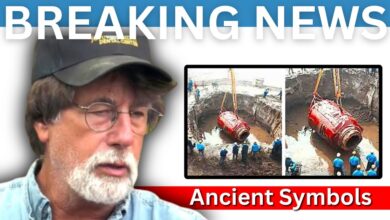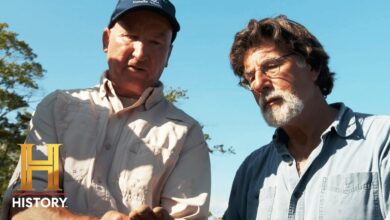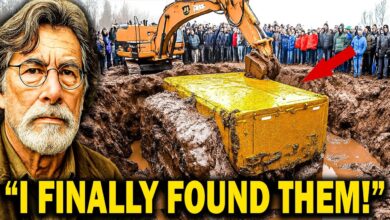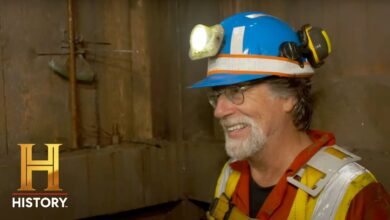Rick Lagina: We Found The Oak Island Mystery!!
Rick Lagina: We Found The Oak Island Mystery!!

Gorgeous. Do you see any marks on any pieces?
No.
Yet?
No.
Oh, look at that.
What you got?
Handle that.
That’s nice.
Yeah, that’s gorgeous. Look at that. Someone would have had money.
Tell you mate, wherever there’s McK, there’s money.
This is great, but they—the archaeologists—can put that together and clean it up.
Maybe there’s marks. Yeah.
In another episode of The Curse of Oak Island, the team continues their search in The Money Pit area, and the drilling to find the lost tunnel continues.
Will there be more to unravel leading to the discovery of the Lost Treasure?
What are the recent findings of the drilling and archaeology team?
Will this episode be a success or will it need more trials, considering what has been done to get to this moment?
Stay tuned as we explore ancient history with modern knowledge, devices, and skills.
The episode opens with Oyen team resuming their quest, and this time, there are more sources to consult.
While going on with the tasks, Alex announces the team is extending to the east in the drilling of D5N 27 to over 100 ft.
Their aim is to verify if indeed there is a tunnel underneath the Garden Shaft.
There is also the possibility that the tunnel seems to have a high concentration of metal material, and by analysis, its contents can only be directed west towards the baby block.
After a series of drillings and 53 ft into the gold, the drilling machine sucked in a mysterious finding covered in very soft and moist underground earth.
This seems to be a good indication, because from previous findings, this type of soil indicates closeness to a tunnel.
Another part of the team holds a meeting at the War Room with a representative of Duma Contracting Limited to discuss updates on furthering their exploration of the Lost Treasure.
A piece of new information was given by the mining and construction company that pushed Oak Island’s team from task suspension to getting back on track.
Finally, the code of conduct for drilling and excavation was approved and permitted by the Nova Scotia Ministry of Labor.
Dumont’s Construction can finally further the deepening of the Garden Shaft.
Since the confirmation, the team’s next step is to speed up their observation and analysis of certain marked spots before the large operation disrupts their study.
The team’s metal detector experts, Gary Drayton and Peter Fornetti, are also caught up in their research along the beach.
The duo’s area of study for this episode is the shoreline of Lot 5.
Their goal is to find clues that denote the indication of metal materials, iron, historical artifacts, and other buried treasures.
Possible areas were marked by flags, and the resting spot for ships—which is the archaeologist’s area of study—was also detected.
There are also indicators of other activities, which is surprising because the Oak Island Treasure was only made public in 1795 and has since been visited and explored by several interested individuals.
Also, some unexplained activities might be traced to the secretive burying of treasures by several people, such as 2,000-year-old Roman coins, lead barter tokens, and Smith’s Cove lead cross.
At the center of Lot 5, there is a rock slab that was obviously constructed to bury and seal something underneath the ground.
Also, close to the park shore, a circular depression area that dates back to about the late 1600s can be found, and it seems similar to the Garden Shaft.
The metal detector experts decided to explore the areas marked by the flag, and their machine confirmed their analysis to be accurate.
There was a strong presence of metal underneath the ground surface.
After careful digging, a cribbing spike was found and analyzed to have been used for most construction done on the island.
Another flag spot led to the discovery of the handle of a snipping tool that traces back to Dan Blankenship’s 1970 discovery of Spanish-originated hand-forged iron scissors.
This snipping tool, when compared, seems to be accurate.
Both artifacts were bagged to be scanned.
The archaeologists of the team, about 50 yards away from the shore, were deep into work, carefully digging into the rectangular depression that is most likely linked to the Garden Shaft.
According to Helen, the rectangular depression is very rare, and this is the first time she has ever worked on one throughout the years in her field.
The unique feature is that the foundation was deep into the ground—almost like it was aimed to be covered up and left undiscovered.
It seems something happened on Lot 5, and there was a deliberate effort to cover all evidence of it.
Only through careful excavation can the mystery be unveiled.
Jack volunteered to sift through the dug-out soil from the depression.
Another piece of green pottery by Jam—so far the biggest piece yet—was found.
Somehow it is possible that all the pieces found would make up a complete piece of greenware.
Several hours passed, and the task of drilling 100 ft into the Money Pit area was still ongoing.
However, another essential discovery was made in D5N 27.
Evidence of wood shafts indicates that there is a different structure beside the tunnel, and it runs east.
The wood at the newly discovered tunnel seems to be stronger, healthier, and closer to the surface than the wood of the tunnel originally sought after.
At about 95 ft to 101 ft into drilling, another object was sucked in by the drilling machine.
This time around, it wasn’t just wood but a large clump of wet soil and some loose materials in it that confirmed that there was indeed another tunnel east of the Garden Shaft.
More discoveries would have been experienced by the team, however their borrowed time was off.
It was time for the Duma Contracting Company team and the Irving Contracting Limited team to step in with the big guns.
The companies arrived with heavy-duty equipment such as 109-ton cranes, which are useful for lifting a 3-ton hammer grab tool and heavy appliances.
The contracting companies began the task of assembling while a new area was being drilled by Alex and the rest of the team.
This new drilling operation is called C5N 27 and is set to begin east of the Garden Shaft.
The purpose of drilling a new area is to further investigate the newly discovered tunnel estimated to be 7.5 ft and over 100 ft deep into the soil.
Another purpose of the C5N 27 drilling operation is Oak Island’s team wanting to construct a new and more sturdy tunnel from below the Garden Shaft.
The drilling for the new borehole had the team working as fast as possible due to time restrictions and because some parts of the area would be restricted from being observed or analyzed for safety reasons during the construction company’s heavy work.
Some members of the team hope to get to the bottom of the newly discovered artifacts.
At Oak Island’s Interpretive Center, a blacksmith expert, Carmen Legge, was consulted to analyze what seemed to be a snipping tool.
The expert confirmed their theory and explained that the reason for the broken piece was because it was the spot where the welded scissor shear was joined to the handle.
The shear handle was compared to a complete set found by Dan Blankenship and was very similar and accurate to assumptions.
However, the newly found scissors are far older than what was found by the island’s hunter.
There is a theory that if the circular depression on Lot 5 and this pair of scissors are traced back to the same date, then there is an unsolved mystery—perhaps something that connects the two together.
It might be clues toward a bigger discovery.
Overall, there might be a 1687 discovery to be found on the island.
The working archaeologists on Lot 5 seem to have discovered several more pieces of ceramics and pearlware.
Only this time, they are white-colored and dated earlier—around the mid-1700s.
Helen believes that at some point, some part of the discovered creamware belonged to a porcelain teapot, and according to history, should be expected for its period.
Another challenging mystery is that it seems these ceramics were already buried before the discovery of Oak Island, and that complicates tracing their origins.
Not long after Oak Island was discovered, it was separated into four acres for easy exploration and excavation by Charles Morris in 1762.
However, it seems the rectangular depression existed before the separation of the island into segments—and definitely before The Money Pit was discovered.
By afternoon, the drilling of the eastern borehole C5N 27 had run several feet deep underground.
At 93 ft, the drilling team was anxious to make another discovery.
However, time was not on their side, and there were no explorations of the area anytime after this.
Before time was up, something rare happened.
The rare dropped down to four—an indicator that the soil underneath was disturbed and very fragile.
After dropping lower to 111 ft, the team finally found a core with wood and confirmed that there was another structure underground, east and below the Garden Shaft.
It is possible that this tunnel might be another passageway—or a mysterious treasure tunnel.
The wood found was agreed to be in good condition at the lower part, and it had an irregular pattern that indicated it was not made with high-tech material, but with human labor.
It was similar to axe cuts on other woods or mechanized saws common during the 1800s.
If this theory is accurate, then the tunnel was most likely built before 1795 by a secret depositor or a searcher.
The second finding from the drilling was a mix of wet soil, fiber, wood chunks, and debris.








